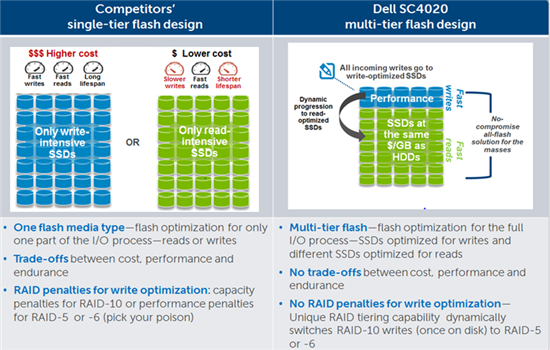 Dell is setting a new bar in affordability for enterprise-class all-flash arrays, making the industry’s most affordable and highest density SSDs available in the SC4020. The Dell SC Series arrays are the first to support new low-cost TLC 3D NAND SSDs, enabling Dell to deliver the lowest $/GB in the industry on both raw and usable flash capacity.1 The new SSDs also give the SC4020 2X greater flash density than previous solutions2 and 6X the density of 15K HDDs for the same $/GB.
Dell is setting a new bar in affordability for enterprise-class all-flash arrays, making the industry’s most affordable and highest density SSDs available in the SC4020. The Dell SC Series arrays are the first to support new low-cost TLC 3D NAND SSDs, enabling Dell to deliver the lowest $/GB in the industry on both raw and usable flash capacity.1 The new SSDs also give the SC4020 2X greater flash density than previous solutions2 and 6X the density of 15K HDDs for the same $/GB.
If you have followed the evolution of disk array architectures over the past several years, you know that the SC Series architecture is highly differentiated based on its capability to intelligently place data blocks at a very granular level on optimized media types. In the past, this was applied to spinning media types. Today, Dell can leverage this same capability—which has been production-proven in thousands of business-critical environments—to give unique advantages in all-flash implementations. It is exactly this design element in the SC Series architecture that enables Dell to leverage TLC SSDs effectively.
There are a number of efficiency-related design elements that contribute to this extraordinary capability. First, flash-to-flash tiering of all active workloads: incoming writes are received on write-optimized SSDs and then dynamically tiered to low-cost read-optimized SSDs. This is all automatically, dynamically done within the array without any operator involvement or any application impact. Second, all incoming data blocks—once on disk—are switched from performance-optimized RAID-10 to capacity-optimized RAID-5 or -6, which takes all the traditional RAID penalties off the table.
Many all-flash array platforms currently have none of these design elements. They optimize around only one flash media type—either the most expensive high-performance SSDs or more often, lower cost formats with reduced endurance and write performance. Many contending all-flash platforms also lack the capability to dynamically tier at the RAID level, so again, you have to choose between the performance advantages of mirrored RAID, which has capacity penalties, or more capacity-friendly parity RAID taxonomies that have performance penalties. The SC Series arrays that take these compromises off the table entirely and as a result, deliver flash capacity that costs the same as spinning disk capacity.4 The SC Series architecture, and the way the Data Progression design feature works with different flash media types, has effected a monumental shift in storage economics that will no doubt advance customers’ productivity on a broader scale than ever before.
Thoughts or questions? We’d love to hear from you in the comments below or engage with us on Twitter.
———————————————————————————————————-
1 Dell is first-to-market with TLC / 3D NAND SSD technology in an enterprise storage array with SC4020 providing up to 90TB flash capacity in 2U for US$150K street price. Dell offers the lowest list and street price on a US$/GB basis for all-flash storage arrays compared to major storage vendors. Pricing is based on a variety of sources including analyst data, price sheets when available, and public information in July 2015. Individual customer’s price may vary based on a variety of circumstances and data should be used for comparison purposes.
2 Compared to previous flash solutions, based on internal Dell analysis, July 2015.
3 Dell SC Series Mainstream RI SSDs provide up to 24x read performance improvement vs. 15K HDD, based on internal system level performance testing. Based on internal Dell US$ pricing analysis, July 2015.
4 For further reference on Dell’s storage solution advantage with TLC/3D NAND flash, see Dell-sponsored IDC White Paper “Driving Business Value with Flash-Optimized Dell Storage Solutions”, January 2015. http://serversrock.intel.com/dell/2014-idc-dell-flash-storage-roi.pdf.
